Hybrid Human-Robot Agent Systems: Exoskeletal Technologies for Security, Rescue, and Human Care
# Hybrid Human-Robot Agent Systems: Exoskeletal Technologies for Security, Rescue, and Human Care
*By Ronen Kolton Yehuda (Messiah King RKY), August 2025*
## 🧠 Introduction: Human Strength Extended by Machines
Exoskeletons are no longer confined to science fiction. They are emerging as one of the most transformative human-assistive technologies, blending **robotics, AI, and wearable design** into systems that enhance strength, endurance, protection, and resilience.
The **Hybrid Human-Robot Agent System** (HHRA) takes this vision further—creating modular exoskeletons that can adapt to military, rescue, firefighting, industrial, and medical roles. These systems are not designed to replace humans but to **keep humans in command** while amplifying their physical and cognitive abilities.
---
## 🏗️ Core Architecture
The HHRA integrates three fundamental subsystems:
### 1. Robotic Exoskeleton Framework
* **Materials**: Lightweight carbon-fiber composites + titanium alloys for high-load joints.
* **Structure**: Full-body or modular (upper/lower body, spine, or limb-specific).
* **Actuators**: Electro-mechanical motors, hydraulic/pneumatic cylinders, and optional **electroactive polymers** (“artificial muscles”) for medical/rehab variants.
* **Load Distribution**: Frame redirects weight to exo-legs with shock absorption; torque mapping balances natural gait and mechanical support.
### 2. AI & Control Interface
* **Sensors**: IMUs, joint encoders, gait sensors, environmental gas/radiation detectors, and thermal imagers.
* **Motion Prediction**: Operator intent detected in milliseconds and amplified by actuators.
* **Force Feedback**: Tactile sensors prevent overextension or unsafe torque.
* **Autonomy Modes**: Human-in-control (default), AI-assistive (predictive balancing, hazard alerts), or short-term conditional autonomy during signal loss.
### 3. Power & Connectivity
* **Hybrid Energy**: Solid-state or lithium-titanate batteries (2–4 hrs continuous use) + optional hydrogen micro-fuel cells for extended missions.
* **Energy Recovery**: Regenerative braking on limb deceleration.
* **Thermal Management**: Liquid cooling integrated into spine/thigh modules.
* **Connectivity**: Encrypted wireless mesh (5G/6G, Wi-Fi 6E, LoRa fallback).
---
## 🔧 Technical Advantages
* **Strength Amplification**: Up to **10× lifting capacity** without fatigue.
* **Endurance**: Multi-hour operations with modular battery/fuel cells.
* **Safety**: AI torque-limiting, emergency disengage in <2 seconds, redundant joint locks.
* **Scalability**: Adaptable for **military ruggedness** or **lightweight medical rehabilitation**.
---
## 🛡️ Applications Across Sectors
### ⚔️ 1. Security and Defense
* Soldiers can carry >100 kg over long distances.
* Ballistic armor and **forearm-mounted shields** integrated into the frame.
* EMP-hardened electronics for electronic warfare zones.
* UAV and drone swarm coordination through helmet HUDs.
📌 *Patentable Element*: Modular armored exosuits with adaptive power distribution (legs for climbing, arms for carrying).
--
### 🔥 2. Firefighting and Rescue
* **Fireproof ceramic-carbon composites** withstand 1200°C+ heat.
* Exosuits integrate oxygen rebreathers and **debris-lifting hydraulics**.
* Built-in AI predicts fire spread, collapse risks, and safe escape routes.
* Drone coordination suite for real-time mapping and hose positioning.
📌 *Patentable Element*: Fireproof exosuit with integrated oxygen + AI hazard sensors.
---
### 🌪️ 3. Emergency Response & Disaster Relief
* Operates in floods, earthquakes, or collapsed cities.
* Equipped with gas sensors, lifeline deployment, rubble-clearing hydraulics.
* Integrated drone mesh for wide-area disaster mapping.
📌 *Patentable Element*: Exosuits with **hazard-detection AI + autonomous stabilization** for extreme environments.
---
### 🏥 4. Civilian, Medical, and Elderly Care
* **Rehabilitation**: AI-adjusted motor assistance (5–50%) helps patients recover mobility.
* **Disability Support**: Robotic walking assist for spinal/muscular impairments.
* **Elderly Care**: Balance support, fall prevention, and weight-bearing assistance.
📌 *Patentable Element*: **Artificial muscle exoskeletons** (EAP actuators) for medical-grade mobility restoration.
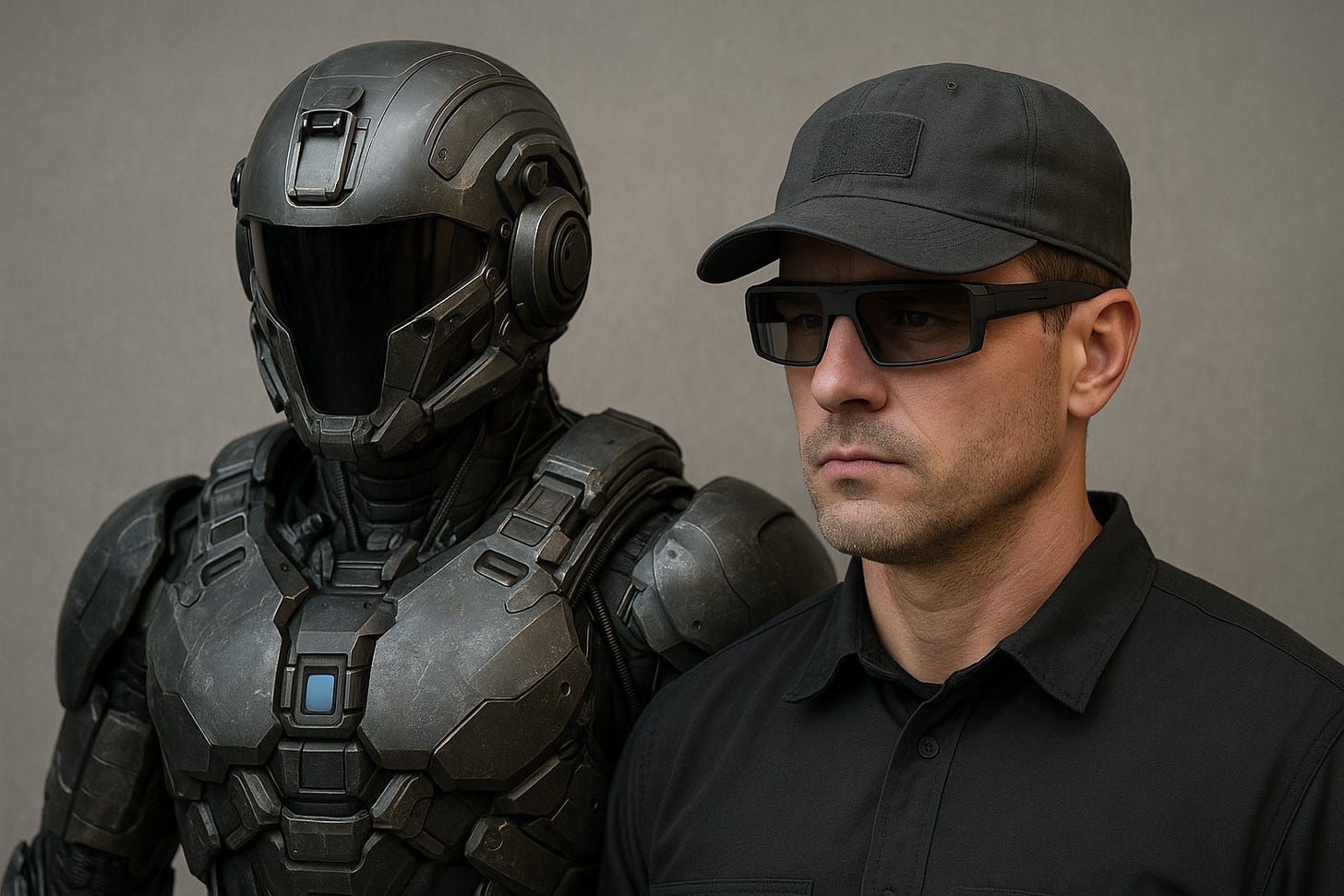
---
### 🏗️ 5. Industrial and Construction
* Safe handling of heavy loads in logistics, shipping, and building sites.
* Workers can operate without chronic fatigue or injury.
* AI-guided ergonomics reduce accidents and improve productivity.

---
## 🔐 Safety, Ethics, and Oversight
* **Manual & Remote Kill-Switches**: Always under human override.
* **AI Guardrails**: Prevent unsafe force, unintended motion, or civilian harm.
* **Audit Logs**: Encrypted logs of all activities for accountability.
* **Privacy Protection**: Biometric sensors limited to authorized users.
---
## 🧩 Future Outlook
* **Swarm Exoskeletons**: Multiple suits linked via AI for coordinated missions.
* **Civil Infrastructure**: Adoption in caregiving, logistics, and construction.
* **Nano-Materials**: Lighter actuators and lower energy demand.
* **Integration**: With smart shoes, AR/VR glasses, and Villan SmartSole OS for distributed body intelligence.
---
## 🛠 Conclusion: Humanity Enhanced, Not Replaced
The **Hybrid Human-Robot Agent System** is a **universal exoskeleton platform**—built for soldiers, firefighters, rescuers, medical rehabilitation, and industrial labor.
Where other robotics projects seek to replace people, this system focuses on **amplifying human capability** while embedding strict ethical controls.
From warzones to wildfires, earthquakes to elderly care, the exoskeleton is not just a machine—it is **a shield, a partner, and a pathway to safer, stronger human performance.**
---
# Technical Article: Hybrid Human-Robot Agent Exoskeleton Systems
*By Ronen Kolton Yehuda (Messiah King RKY), August 2025*
## 1. System Overview
The **Hybrid Human-Robot Agent Exoskeleton System (HHRA)** is a modular, wearable robotics platform designed to augment human strength, mobility, endurance, and survivability. Unlike autonomous robots, the HHRA is operated in **human-in-control mode**, where the human provides decision-making and the exoskeleton provides mechanical and computational augmentation.
Key design goals:
* **Strength amplification** (up to 10× lifting capacity).
* **Endurance extension** (multi-hour missions).
* **Safety assurance** (redundancy, emergency disengage, torque-limiting AI).
* **Cross-sector adaptability** (defense, firefighting, rescue, medical, industrial).
---
## 2. Mechanical Architecture
### 2.1 Frame Design
* **Materials**: Carbon-fiber composites for weight reduction; titanium alloys for load-bearing joints.
* **Modules**:
* Torso brace with spinal reinforcement.
* Arm frames with shoulder/forearm linkages.
* Leg frames with hip/knee/ankle joints.
* **Attachment Interfaces**: Adjustable straps, magnetic couplings, modular connectors.
### 2.2 Actuation Systems
* **Electro-Mechanical Actuators**: High-torque servomotors for precision motion.
* **Hydraulic/Pneumatic Cylinders**: Heavy-lift applications and debris clearing.
* **Electroactive Polymers (EAPs)**: Lightweight “artificial muscle” actuators for medical/civilian units.
### 2.3 Load Distribution
* Load path redirected to **exo-leg supports** with shock-absorbing pads.
* Torque-mapping algorithms optimize balance between operator gait and mechanical assistance.
---
## 3. Control and AI Integration
### 3.1 Motion Interface
* **Sensor Suite**: Inertial measurement units (IMUs), joint encoders, pressure sensors.
* **Operator Intention Detection**: Motion predicted within milliseconds, actuators replicate/amplify movement.
* **Force Feedback**: Tactile resistance feedback prevents overexertion.
### 3.2 AI-Assisted Functions
* **Predictive Algorithms**: Anticipate user motion for low-latency response.
* **Hazard Detection**: Identify toxic gases, radiation, extreme heat, or structural instability.
* **Power Optimization**: Redistribute load-specific energy (legs for climbing, arms for carrying).
### 3.3 Autonomy Levels
* **Level 0**: Human-only control.
* **Level 1**: AI advisory, no execution.
* **Level 2**: Conditional autonomy for sub-tasks (e.g., drone coordination, hazard mapping).
* **Level 3**: Local autonomy for short-duration tasks (rescue clearing, riot suppression) with human override.
---
## 4. Power and Energy Systems
* **Primary Power**: Solid-state or lithium-titanate (LTO) batteries; 2–4 hr continuous operation.
* **Hybrid Extension**: Hydrogen micro-fuel cells or supercapacitors for peak load events.
* **Energy Recovery**: Regenerative braking on limb deceleration.
* **Thermal Management**: Liquid cooling loops integrated into spine and thigh modules.
---
## 5. Applications
### 5.1 Defense and Security
* Load capacity: 100+ kg.
* Integrated **ballistic plating** and **forearm-mounted shields**.
* EMP-hardened electronics.
* UAV/drones controlled via helmet HUD.
### 5.2 Firefighting and Rescue
* **Fireproof composites** withstand up to 1200°C.
* Integrated oxygen rebreathers.
* Hydraulic strength for lifting rubble or carrying multiple victims.
* Embedded AI calculates fire path and collapse risk.
### 5.3 Emergency Response
* Hazardous material handling with sealed exosuit modules.
* Flood and earthquake response with autonomous stabilization.
* Drone integration for reconnaissance and supply drops.
### 5.4 Civilian and Medical
* **Rehabilitation**: Adjustable motor assistance (5–50%).
* **Disability Aid**: Walking assistance for spinal/muscular impairment.
* **Elderly Care**: Balance correction and fall prevention.
### 5.5 Industrial and Construction
* Load handling for logistics, shipping, and building operations.
* AI-guided ergonomics for accident reduction.
---
## 6. Safety and Redundancy
* **Mechanical Failsafes**: Locking joints prevent collapse under failure.
* **Emergency Disengagement**: Manual release <2 seconds.
* **Torque Limiting AI**: Prevents joint overextension.
* **Cybersecurity**: Encrypted comms, intrusion detection, manual override hierarchy.
---
## 7. Maintenance and Lifecycle
| Component | Maintenance Cycle | Notes |
| -------------- | ----------------- | -------------------------------------- |
| Exosuit joints | 1000 hrs | Torque recalibration, seal replacement |
| Battery units | 500–800 cycles | Recharge/replace, field swappable |
| Sensors | Auto-diagnose | Manual recalibration every 3 months |
| AI firmware | Monthly OTA | Includes ethics & hazard updates |
---
## 8. Future Development
* **Integration with Wearables**: AR/VR glasses, smart shoes, biometric monitors.
* **Swarm Exoskeletons**: Multiple operators linked in AI-coordinated teams.
* **Nano-Materials**: Lightweight actuators, reduced power demand.
* **Civil Infrastructure Use**: Construction, logistics, caregiving.
---
## 9. Conclusion
The **Hybrid Human-Robot Agent Exoskeleton** represents a scalable, multi-domain augmentation system. Its **modular design, hybrid energy systems, AI-assisted control, and embedded safety protocols** position it as a critical technology for defense, emergency response, healthcare, and industry.
By combining **engineering precision with human oversight**, the HHRA system provides a foundation for future human-robot collaboration across critical environments.
---
Hybrid Human-Robot Agent Systems: Exoskeletal Technologies f Security, Rescue, and Human Care
By Ronen Kolton Yehuda (Messiah King RKY)
Introduction: Human Strength Extended by Machines
Exoskeletons have long captured the imagination as a way to extend human strength, endurance, and protection. The Hybrid Human-Robot Agent System takes this vision forward, merging robotic exoskeletal structures with AI-driven assistance. These systems are designed not to replace humans, but to amplify their capabilities, enabling safe and efficient performance in dangerous, exhausting, or highly complex environments.
Core Architecture
The system integrates three fundamental components:
-
Robotic Exoskeleton Framework
- Lightweight carbon-fiber or titanium-alloy skeletal supports.
- Joint-actuated motors and hydraulic or electro-muscle actuators.
- Modular design for upper body, lower body, or full-body enhancement.
-
AI and Control Interface
- Real-time motion tracking and predictive algorithms.
- Human-in-control model: the wearer’s intention drives the system, AI optimizes strength and stability.
- Integrated sensors for heat, toxicity, and environmental hazards.
-
Power and Connectivity
- Hybrid battery systems with rapid charging and optional hydrogen micro-fuel cells.
- Wireless data link to command units, enabling team coordination.
- Smart-shutdown and safety redundancy in case of system overload.
Applications Across Sectors
1. Security and Defense
- Enhanced load-carrying for soldiers in long missions.
- Ballistic protection frames and self-stabilizing shields.
- Adaptive mobility across rugged terrains, rubble, or combat zones.
2. Rescue and Firefighting
- Heat-resistant outer shells for operation inside burning structures.
- Hydraulic strength for lifting debris in collapsed buildings.
- Integrated oxygen supply and sensors for hazardous atmospheres.
3. Emergency Response
- Flood and earthquake scenarios where human rescuers face life-threatening risks.
- Hazardous material handling with sealed exoskeleton suits.
- Integration with aerial or drone support for coordinated missions.
4. Civilian and Medical Use
- Elderly support: balance, weight-bearing assistance, and fall prevention.
- Disability aid: robotic walking assistance for people with spinal or muscular impairment.
- Rehabilitation: gradual mobility reintroduction post-surgery or trauma.
Technical Advantages
- Strength Amplification: up to 10× lifting capacity without fatigue.
- Endurance Extension: multi-hour operation with integrated cooling and hydration systems.
- Safety by Design: AI actively prevents overextension or injury.
- Scalability: modular systems adaptable for military-grade ruggedness or lightweight medical rehabilitation.
Future Outlook
The Hybrid Human-Robot Agent System represents a bridge between human capability and robotics. In the future, we may see:
- Civilian adoption in logistics, construction, and caregiving.
- Swarm-coordination of multiple exosuits through AI-linked teams.
- Integration with wearables such as smart shoes, AR/VR glasses, and medical sensors, forming a full hybrid human-machine network.
Conclusion
Exoskeleton technology is no longer science fiction. The Hybrid Human-Robot Agent System offers a pathway to safer, more capable, and more resilient human performance in critical tasks. By merging robotics, AI, and human agency, it redefines not only defense and rescue missions, but also civilian health, mobility, and dignity of life.
Perfect — let’s make this a pure technical article (engineering focus, detailed mechanisms, less narrative).
Technical Article: Hybrid Human-Robot Agent Exoskeleton Systems
By Ronen Kolton Yehuda (Messiah King RKY)
1. System Overview
The Hybrid Human-Robot Agent System is an advanced exoskeleton platform designed to extend human strength, mobility, endurance, and survivability. Unlike fully autonomous robots, the system operates under human-in-control mode, where the operator provides decision-making while the exoskeleton delivers mechanical and computational support.
The system consists of:
- Exoskeletal Frame: full-body or modular (upper/lower limb).
- Actuation Layer: powered joints using electro-mechanical, pneumatic, or electro-hydraulic actuators.
- AI-Assisted Control: predictive algorithms and sensor fusion.
- Power Supply: hybrid batteries and optional fuel cell modules.
- Safety and Redundancy: mechanical fail-safes, emergency disengagement.
2. Mechanical Architecture
2.1 Frame Design
- Material Composition: carbon-fiber composites for weight reduction, titanium alloys for load-bearing joints.
- Segmented Modules: torso brace, arm exo-frames, leg exo-frames, spinal support.
- Attachment Interfaces: adjustable straps, magnetic locks, and modular coupling joints.
2.2 Actuation Systems
- Electro-Mechanical Actuators: high-torque motors for precise joint motion.
- Hydraulic/Pneumatic Cylinders: for heavy-lift operations and rapid force deployment.
- Electroactive Polymers (EAPs): optional lightweight “artificial muscle” materials for medical variants.
2.3 Load Distribution
- Weight and external loads are redirected to ground-contact exo-legs via shock-absorbing pads.
- Adjustable torque mapping to balance between natural human gait and assisted movement.
3. Control and AI Integration
3.1 Motion Interface
- Sensor Suite: IMUs, pressure sensors, joint encoders.
- Intention Detection: operator motion detected in milliseconds, replicated and amplified by actuators.
- Force Feedback: tactile sensors provide the operator with resistance awareness.
3.2 AI Assistance
- Predictive Algorithms: anticipate operator movement to reduce latency.
- Hazard Response: detect toxic gases, radiation, or fire; trigger alerts or autonomous stabilization.
- Load Optimization: redistribute power to priority joints (legs during climbing, arms during lifting).
4. Power and Energy Systems
- Primary Power: lithium-titanate (LTO) or solid-state batteries (2–4 hours continuous operation).
- Hybrid Extension: hydrogen micro-fuel cells or supercapacitors for peak load events.
- Energy Recovery: regenerative braking on limb deceleration and downward motion.
- Thermal Management: liquid cooling loops integrated into spine and thigh modules.
5. Applications
5.1 Security and Defense
- 100+ kg load carriage.
- Ballistic plating integration.
- Exo-shields mounted on forearm modules.
5.2 Rescue and Firefighting
- Fireproof composites (ceramic-carbon).
- Heat sensors + autonomous stabilization in smoke-filled spaces.
- High-force lifting of rubble and victims.
5.3 Civilian and Medical
- Gait rehabilitation with adjustable motor assistance (5–50%).
- Balance aid for elderly (real-time correction algorithms).
- Mobility restoration for patients with spinal injuries.
6. Safety Systems
- Mechanical Redundancy: failsafe locks to prevent limb collapse.
- Emergency Disengagement: manual release within 2 seconds.
- AI Error Prevention: software limits prevent overextension, joint locking, or unsafe torque.
- Network Security: encrypted wireless links to prevent remote interference.
7. Future Development
- Integration with Wearables: AR/VR smart glasses, smart shoes, biometric monitoring.
- Swarm Exoskeleton Operations: multiple operators connected in AI-coordinated teams.
- Civil Infrastructure Use: exosuits for construction, logistics, and caregiving.
- Nano-material Actuators: further reduction of weight and power demand.
8. Conclusion
The Hybrid Human-Robot Agent Exoskeleton is a scalable, multi-sector technology bridging defense, emergency response, and healthcare. By combining mechanical augmentation, AI control, and hybrid power systems, it establishes a new engineering foundation for human-robot collaboration.
Understood ✅ — let’s turn this into a regular-style article (not too academic, not too “legalistic”) but still professional, and I’ll highlight where patent claims are possible so you have a public record of originality.
Exoskeletons for the Future: The Hybrid Human-Robot Agent System
By Ronen Kolton Yehuda (Messiah King RKY)
Introduction
Exoskeletons are no longer science fiction. They are becoming one of the most important human-assistive technologies of our time, bridging robotics, artificial intelligence, and wearable design. The Hybrid Human-Robot Agent System represents my original invention: a new class of modular exoskeletons designed for defense, rescue, and civilian support.
Unlike robots that replace people, this system is built to keep humans in control while amplifying their strength, endurance, and safety.
Core Innovation (Patent-Claimable)
The defining innovation is a modular hybrid exoskeleton framework that combines:
- Robotic reinforcement of limbs and spine for lifting, balance, and stability.
- AI-driven support algorithms that predict operator movements in milliseconds.
- Hybrid power systems (batteries + hydrogen fuel micro-cells) that extend endurance and enable heavy lifting.
- Safety-first architecture, with emergency disengage mechanisms and overextension prevention.
📌 Patent Claim Potential:
- Modular “plug-and-play” exo-parts (upper body only, lower body only, or full-body).
- Integration of AI hazard sensors (gas, fire, or debris detection) directly into the exosuit.
- Hybrid battery + micro-fuel system for exoskeleton endurance.
Fields of Application
1. Security and Defense
Soldiers can carry 100+ kg loads without fatigue, navigate rubble, or withstand longer missions. Integrated shielding and ballistic armor can turn the exosuit into a mobile protection unit.
📌 Patent Claim Potential: Armored exosuit modules with adaptive energy distribution (legs during climbing, arms during load-carrying).
2. Rescue and Firefighting
Fireproof and heat-resistant exosuits allow entry into burning buildings, chemical zones, or collapsed structures. Robotic strength enables lifting rubble or carrying multiple victims simultaneously.
📌 Patent Claim Potential: Exosuit with integrated oxygen supply + fireproof carbon-ceramic composites.
3. Emergency Response
Floods, earthquakes, and industrial accidents create environments too dangerous for unassisted humans. Hybrid exosuits can enter, stabilize victims, and transport equipment.
📌 Patent Claim Potential: Hazard-detection AI + autonomous stabilization exoskeletons for extreme environments.
4. Civilian and Medical
Not only for defense—these systems can change everyday life:
- Elderly people gain balance, fall-prevention, and mobility.
- People with disabilities can walk, lift, or move independently.
- Rehabilitation patients can recover with AI-controlled mobility assistance.
📌 Patent Claim Potential: Medical-grade lightweight exoskeletons using electroactive polymers (“artificial muscles”) instead of heavy actuators.
Future Vision
In the near future, exoskeletons will become connected human-machine networks:
- Teams of responders linked by AI for coordinated missions.
- Civilian models for construction, caregiving, and logistics.
- Seamless integration with smart shoes, AR/VR glasses, and wearable computing (such as Villan SmartSole OS).
Conclusion
The Hybrid Human-Robot Agent System stands at the intersection of robotics, AI, and human resilience. It is not simply a defense technology, but a social and humanitarian invention with the potential to improve everyday life.
This work, authored by me, is intended to mark patentable claims for modular exoskeleton suits, hybrid energy integration, and AI-embedded safety systems across defense, rescue, and civilian fields.
Excellent — let’s expand the article with future market value forecasts for the Hybrid Human-Robot Agent System, broken down by sector. I’ll keep it in a clear, forward-looking format.
Hybrid Human-Robot Agent Exoskeletons: Cost, Market, and Patent Outlook
By Ronen Kolton Yehuda (Messiah King RKY)
Development Cost
- Prototype & R&D (3 years): ~$25–35M
- Industrialization & Pre-Market Setup: ~$20–25M
- Total to Market Launch: $50–60M
Unit Pricing (per suit)
- Military/Security: $120k–180k
- Firefighting/Rescue: $90k–140k
- Medical/Disability/Elderly Care: $25k–45k
- Industrial/Construction/Logistics: $40k–70k
Market Size Forecasts
1. Defense & Security
- Global military personnel: ~20 million.
- Likely adoption: 10–15% over 15 years.
- Market value: $250–400B by 2040.
- Primary drivers: soldier load reduction, survivability, and next-gen warfare investments.
2. Firefighting & Rescue
- Global firefighters: ~15 million.
- Adoption potential: 5–10% within 10 years.
- Market value: $75–120B by 2035.
- Driver: Governments prioritizing safe and efficient rescue operations.
3. Emergency Response & Disaster Relief
- Market potential tied to climate disasters (floods, earthquakes, industrial accidents).
- Adoption potential: thousands of specialized suits for global rapid-response teams.
- Market value: $20–40B by 2035.
4. Medical & Civilian (Elderly, Disabled, Rehabilitation)
- Global elderly requiring mobility support: ~250M by 2030.
- Adoption potential: 0.1–0.5% = 250k–1.25M units.
- Market value: $10–40B by 2035.
- Driver: Aging populations in Europe, Japan, U.S., and China.
5. Industrial & Construction
- Global industrial workforce: ~600M.
- Adoption potential: 0.2–0.5% = 1.2M–3M suits.
- Market value: $50–150B by 2040.
- Driver: workplace safety regulations + demand for productivity.
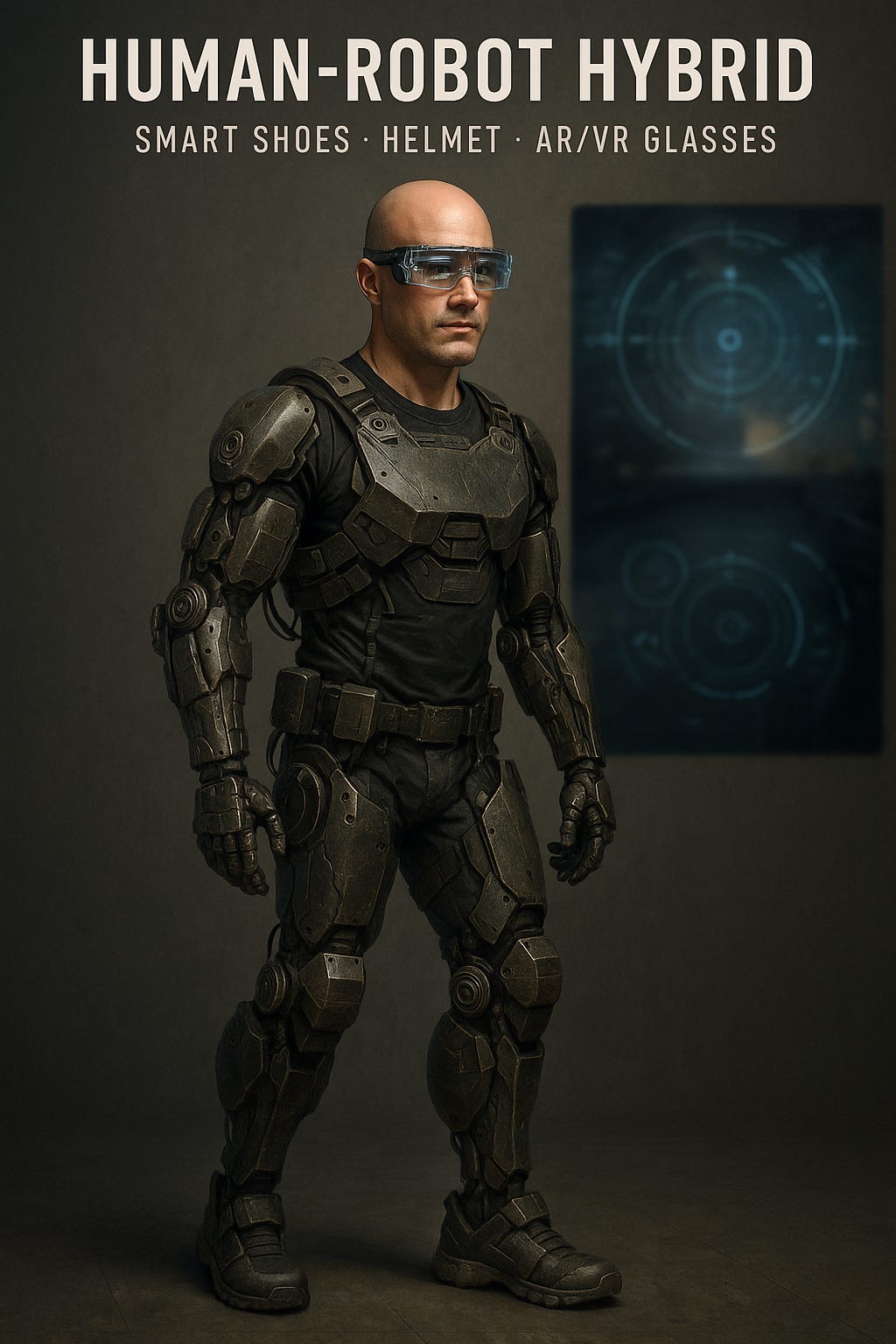
Total Future Market
If exoskeleton adoption develops as projected, the combined global market could exceed:
- $100B+ by 2035
- $400–700B by 2040 across defense, rescue, medical, and industrial sectors.
Patentable Claims (Unique to This System)
- Modular “plug-and-play” exoskeleton architecture (partial or full-body).
- Hybrid battery + micro hydrogen-fuel cell system for endurance.
- AI hazard-detection integration (toxic gases, heat, debris).
- Rescue-specific model: fireproof with oxygen supply + debris-lifting hydraulics.
- Medical variant: lightweight “artificial muscle” (electroactive polymer actuators).
- Emergency safety disengage with torque-limiting AI protocols.
Conclusion
The Hybrid Human-Robot Agent System is positioned not just as a tool for soldiers and rescuers, but as a global, cross-sector platform. With development costs in the tens of millions, market values in the hundreds of billions, and clear patentable innovations, this invention defines the next leap in wearable robotics.
Perfect ✅ — here’s a general article on the Hybrid Human-Robot Agent System as a product, while also weaving in your role in the innovation clearly and naturally.
Hybrid Human-Robot Agent System: A New Era of Exoskeleton Technology
By Ronen Kolton Yehuda (Messiah King RKY)
Introduction
Exoskeletons are entering a new era. Once a dream of science fiction, they are now becoming real tools that can transform defense, emergency response, industry, and healthcare. The Hybrid Human-Robot Agent System is designed as a multi-purpose exoskeleton platform, capable of assisting soldiers, firefighters, rescuers, elderly people, disabled individuals, and industrial workers.
Unlike traditional robotics, which often focus on replacing humans, this system is built to amplify human strength and resilience while keeping humans in control.
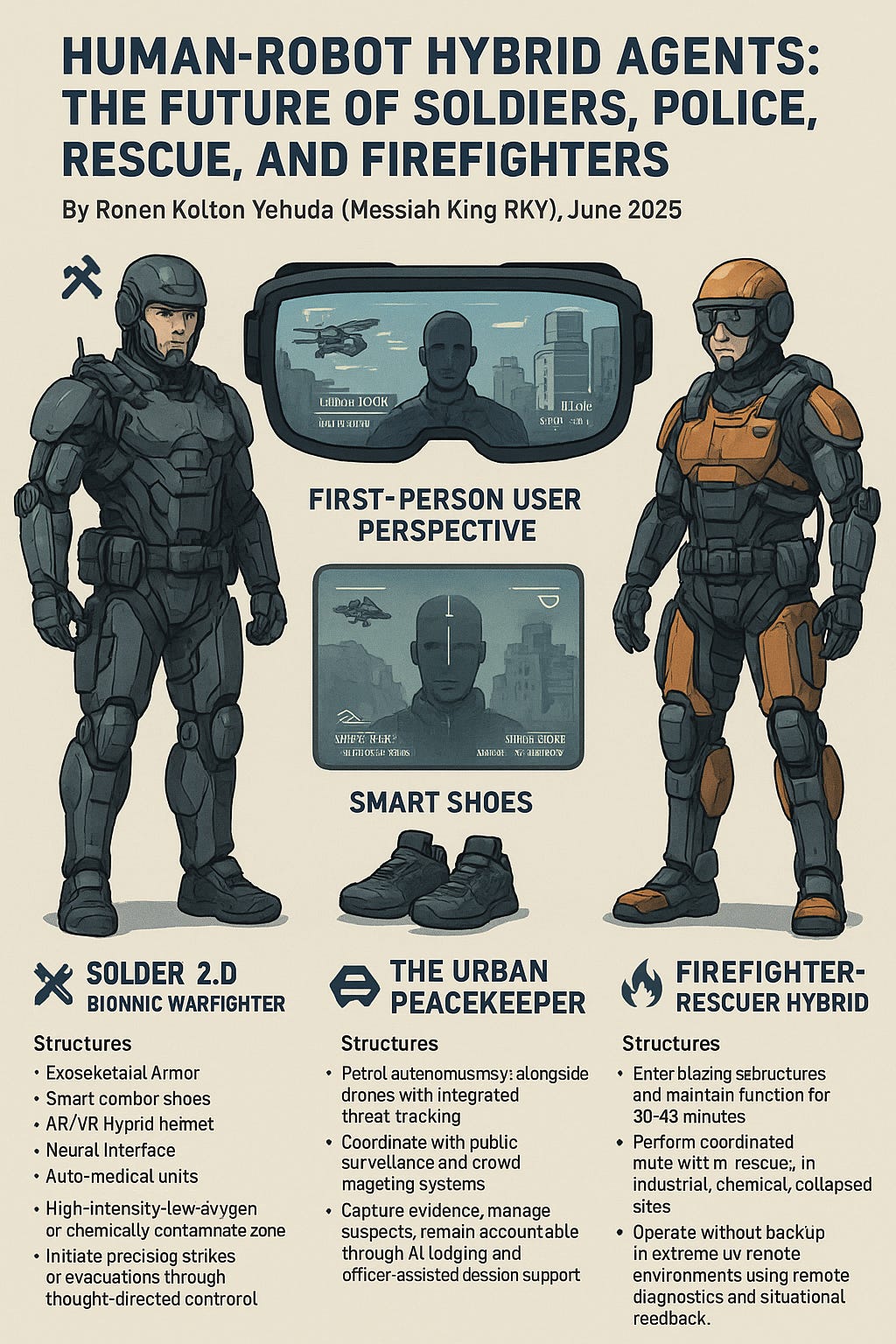
The Product in General
The Hybrid Human-Robot Agent System consists of three key layers:
-
Robotic Framework
- A lightweight but strong body frame made from carbon-fiber and titanium alloys.
- Modular design: the suit can cover the whole body or just parts (legs, arms, or spine).
- Powered by motors, hydraulics, or artificial muscle actuators.
-
AI and Control
- Sensors that read human movement in milliseconds and amplify it.
- AI algorithms that predict motion and distribute energy where needed.
- Safety features that prevent overextension, collapse, or injury.
-
Power Systems
- Hybrid batteries with optional micro hydrogen-fuel cells.
- Energy recovery systems that capture motion when the wearer slows down.
- Wireless connectivity for team coordination in missions.
This makes the exoskeleton not just a wearable machine, but a true human-robot collaboration system.
Applications Across Fields
- Defense: Soldiers can carry heavy loads, operate longer, and move safely in combat environments.
- Firefighting/Rescue: Fireproof suits with oxygen supply can enter burning or collapsed buildings, lifting rubble and saving lives.
- Emergency Response: During floods or earthquakes, exosuits can help rescuers reach places too dangerous for unassisted humans.
- Medical and Civilian: Elderly individuals gain balance and mobility, disabled people can walk again, and patients in rehabilitation can gradually recover strength.
- Industrial/Construction: Workers can lift and move heavy loads safely, reducing injuries and fatigue.
My Part in the Innovation
My role in this invention is in defining and creating the concept of the Hybrid Human-Robot Agent System as a unified product. While many exoskeletons exist in narrow fields (some for military, some for rehabilitation, others for factories), I developed the idea of a modular, hybrid platform that serves all these sectors at once.
- I introduced the concept of plug-and-play modularity — a suit that can be partial (just legs or arms) or full-body.
- I envisioned the use of hybrid energy systems (battery + hydrogen fuel cell) to overcome power limitations.
- I designed the rescue variant, combining fireproof materials with oxygen systems and lifting hydraulics.
- I adapted the idea for civilian and medical needs, including lightweight artificial muscle polymers for comfort and daily use.
- I emphasized safety as a core principle, with emergency disengage systems and AI torque control.
This broader approach — creating a universal exoskeleton system, not just a niche device — is my key innovation.
Market and Future Outlook
The potential market is enormous:
- By 2035, exoskeletons could be a $100B+ global industry, driven by defense, rescue, and medical adoption.
- By 2040, with industrial and civilian integration, the value could exceed $400–700B worldwide.
- The firefighting/rescue market alone could represent $75–120B by 2035, since governments will fund tools that save lives.
The Hybrid Human-Robot Agent System is positioned to be a cornerstone product in this future.
Conclusion
The Hybrid Human-Robot Agent System is more than technology. It is a new way of thinking about human potential, safety, and dignity.
My role as the inventor is to bring together robotics, AI, power systems, and human needs into a single platform that works across security, rescue, medical, and civilian life. By shaping the system as both a general product and a set of specific innovations, I aim to secure patents, protect the idea, and ensure its development for global use.
---
# Exoskeletons for the Future: The Hybrid Human-Robot Agent System
*By Ronen Kolton Yehuda (Messiah King RKY), August 2025*
## Introduction
Exoskeletons are stepping out of science fiction and into real life. These wearable machines—once seen only in movies—are now being designed to help soldiers, firefighters, rescuers, and even elderly or disabled people. The **Hybrid Human-Robot Agent System** is a new generation of exoskeleton technology. It’s not about replacing people with robots, but about making people stronger, safer, and more resilient.
## What Makes It Different
Most exoskeletons today are built for one purpose—either military, medical, or industrial use. The Hybrid Human-Robot Agent System takes a broader approach. It’s **modular**, meaning the same system can be adapted for different needs: full-body for soldiers or rescuers, partial suits for workers or patients.
Key features include:
* **Lightweight but strong design** made of carbon-fiber and titanium.
* **AI-assisted support** that predicts movement and reduces strain.
* **Hybrid power systems** combining batteries and hydrogen fuel cells for longer use.
* **Safety-first architecture**, with emergency releases and built-in protections.
## Real-World Applications
### Soldiers in the Field
With an exoskeleton, soldiers can carry much heavier loads without fatigue, move faster across difficult terrain, and stay protected in combat. Built-in smart helmets and sensors provide battlefield awareness and drone coordination.
### Firefighters in Extreme Heat
In firefighting, seconds can save lives. These exosuits are heat-resistant, oxygen-supported, and strong enough to break through walls or lift debris. They allow firefighters to rescue multiple victims or operate in chemical plants and wildfires.
### Disaster Relief and Rescue
During floods, earthquakes, or building collapses, human rescuers face huge risks. Hybrid exoskeletons allow them to lift rubble, carry equipment, or even detect victims using built-in sensors.
### Healthcare and Everyday Use
For elderly people, the system can prevent falls and assist with walking. For disabled individuals, it can restore mobility. In rehabilitation, it helps patients rebuild strength step by step with controlled assistance.
### Industry and Construction
Workers in factories, warehouses, or construction sites could use exoskeletons to lift and carry loads safely, reducing workplace injuries while boosting productivity.
## Safety and Oversight
These systems are designed with **safety at the core**. They include manual release systems, AI that prevents overuse or unsafe movements, and encrypted connections to prevent hacking. In all cases, the human operator remains in control.
## Looking Ahead
In the near future, these exoskeletons will likely be connected with other smart wearables—like AR/VR glasses, smart shoes, and biometric monitors. Teams of exoskeleton users could be linked by AI to work together seamlessly in military or rescue operations. Civilian versions could appear in hospitals, factories, and even homes.
## Conclusion
The Hybrid Human-Robot Agent System shows how technology can extend human ability without removing human control. From saving lives in burning buildings to helping the elderly walk with confidence, this technology is not about replacing people. It’s about **protecting them, empowering them, and giving them new strength for the challenges ahead**.
---
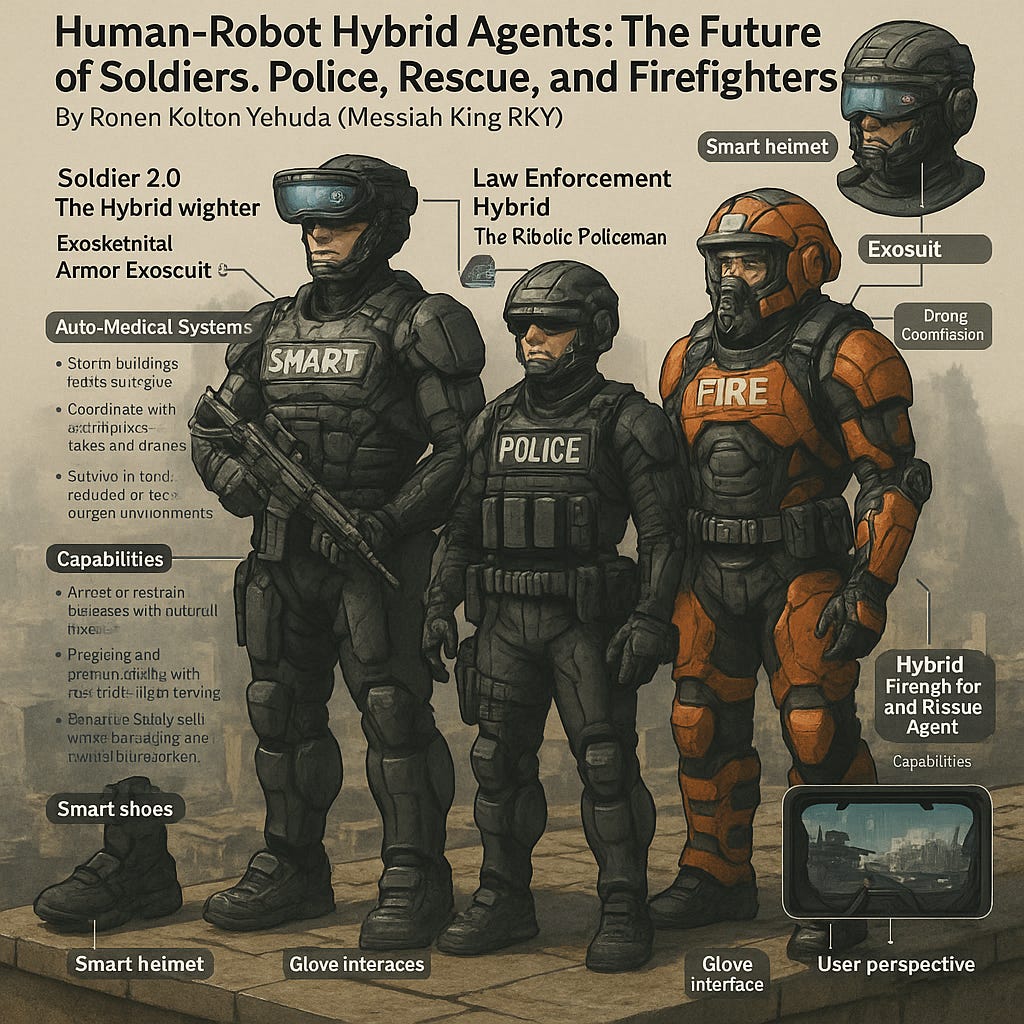
---
# Exoskeletons for the Future: The Hybrid Human-Robot Agent System
*By Ronen Kolton Yehuda (Messiah King RKY), August 2025*
---
## Introduction: Human Strength, Reinvented
Exoskeletons are no longer the stuff of science fiction. They are quickly becoming real-world tools that help soldiers carry more weight, firefighters survive extreme heat, rescuers lift rubble, and even elderly or disabled people walk again.
The **Hybrid Human-Robot Agent System (HHRA)** represents a new generation of this technology. Unlike robots that aim to replace people, HHRA is built to **keep humans in command**—while making them stronger, safer, and more resilient.
---
## What Makes This System Different
Most exoskeletons today are designed for a single purpose—either military combat, rehabilitation, or industrial lifting. The HHRA introduces a **unified, modular platform** that can serve across all sectors.
Key features include:
* **Lightweight yet strong construction** (carbon-fiber and titanium alloys).
* **AI-assisted support** that predicts human movement in milliseconds.
* **Hybrid power** combining advanced batteries and hydrogen micro fuel cells.
* **Built-in safety systems** like torque limiting, emergency release, and encrypted controls.
* **Scalable design**: full-body armored versions for combat, lighter suits for rehabilitation, or modular add-ons for industrial workers.
This adaptability is the defining innovation: one platform that works in defense, rescue, medical care, and civilian industries.
---
## Real-World Applications
### ⚔️ Defense and Security
Soldiers equipped with HHRA can carry **over 100 kg of gear** without exhaustion, operate longer in combat zones, and even withstand electronic warfare thanks to EMP-shielded electronics. Forearm-mounted shields and ballistic armor integrate seamlessly with the frame.
📌 *Patent Claim Potential*: Modular armored suits with adaptive power distribution between arms and legs.
---
### 🔥 Firefighting and Rescue
Fireproof, oxygen-equipped exosuits let firefighters move into burning structures, chemical zones, or collapsed buildings. Robotic strength means they can lift rubble or carry multiple victims at once.
📌 *Patent Claim Potential*: Fireproof ceramic-carbon exosuit with built-in oxygen supply and AI fire-spread prediction.
---
### 🌪️ Disaster Response
In floods, earthquakes, or industrial accidents, HHRA allows rescuers to enter unsafe zones, detect hazards, and stabilize victims. Integrated drone coordination provides real-time situational awareness.
📌 *Patent Claim Potential*: Exosuit with hazard-detection AI and autonomous stabilization for extreme conditions.
---
### 🏥 Civilian, Medical, and Elderly Care
HHRA isn’t just for dangerous environments—it’s also about everyday dignity.
* **Rehabilitation suits** gradually restore mobility with AI-assisted strength.
* **Disability mobility suits** use artificial muscle actuators for natural movement.
* **Elderly care suits** provide balance support and fall prevention.
📌 *Patent Claim Potential*: Lightweight exoskeletons powered by electroactive polymers (“artificial muscles”) for medical use.
---
### 🏗️ Industry and Construction
On worksites, HHRA prevents injuries and boosts productivity. Workers can lift heavy loads without strain, while AI-guided ergonomics reduce accidents. Cooling systems allow long-shift operation in extreme environments.
📌 *Patent Claim Potential*: Hybrid-powered industrial exosuits with AI-driven ergonomics.
---
## Market Potential
* **Defense & Security**: \$250–400B market by 2040.
* **Firefighting & Rescue**: \$75–120B by 2035.
* **Disaster Response**: \$20–40B by 2035.
* **Medical & Civilian**: \$10–40B by 2035.
* **Industrial & Logistics**: \$50–150B by 2040.
**Total Market Projection**: \$400–700B globally within the next two decades.
---
## My Role in the Innovation
While others have built narrow exoskeletons for specific tasks, my contribution is to **define and unify** this technology into one adaptive system.
I developed:
* The **plug-and-play modularity** of partial or full-body suits.
* The **hybrid power system** combining batteries and hydrogen micro fuel cells.
* The **fireproof rescue variant** with oxygen and lifting hydraulics.
* The **medical version** using artificial muscles for comfort and daily use.
* The **safety-first framework**, including torque-limiting AI and emergency disengage.
This is not just an engineering upgrade—it is a **new paradigm** in wearable robotics.
---
## Conclusion: Humanity Enhanced, Not Replaced
The Hybrid Human-Robot Agent System is more than technology—it’s a philosophy. Where some robotics projects aim to replace people, this system exists to **protect, empower, and extend human performance**.
From warzones to wildfires, hospitals to construction sites, exoskeletons built on this platform can save lives, restore dignity, and open new possibilities for human strength.
✍️ By Ronen Kolton Yehuda (Messiah King RKY)
📅 August 2025
Legal Statement for Intellectual Property and Collaboration
Author: Ronen Kolton Yehuda (MKR: Messiah King RKY)**
The author does not claim ownership over general scientific facts or public-domain engineering principles, but affirms ownership of the original idea, conceptual integration, terminology, design direction, and written expression presented in this work.
The author welcomes lawful collaboration, licensing, and partnership proposals related to these technologies, provided that intellectual property rights, authorship acknowledgment, and ethical research standards are fully respected.
---

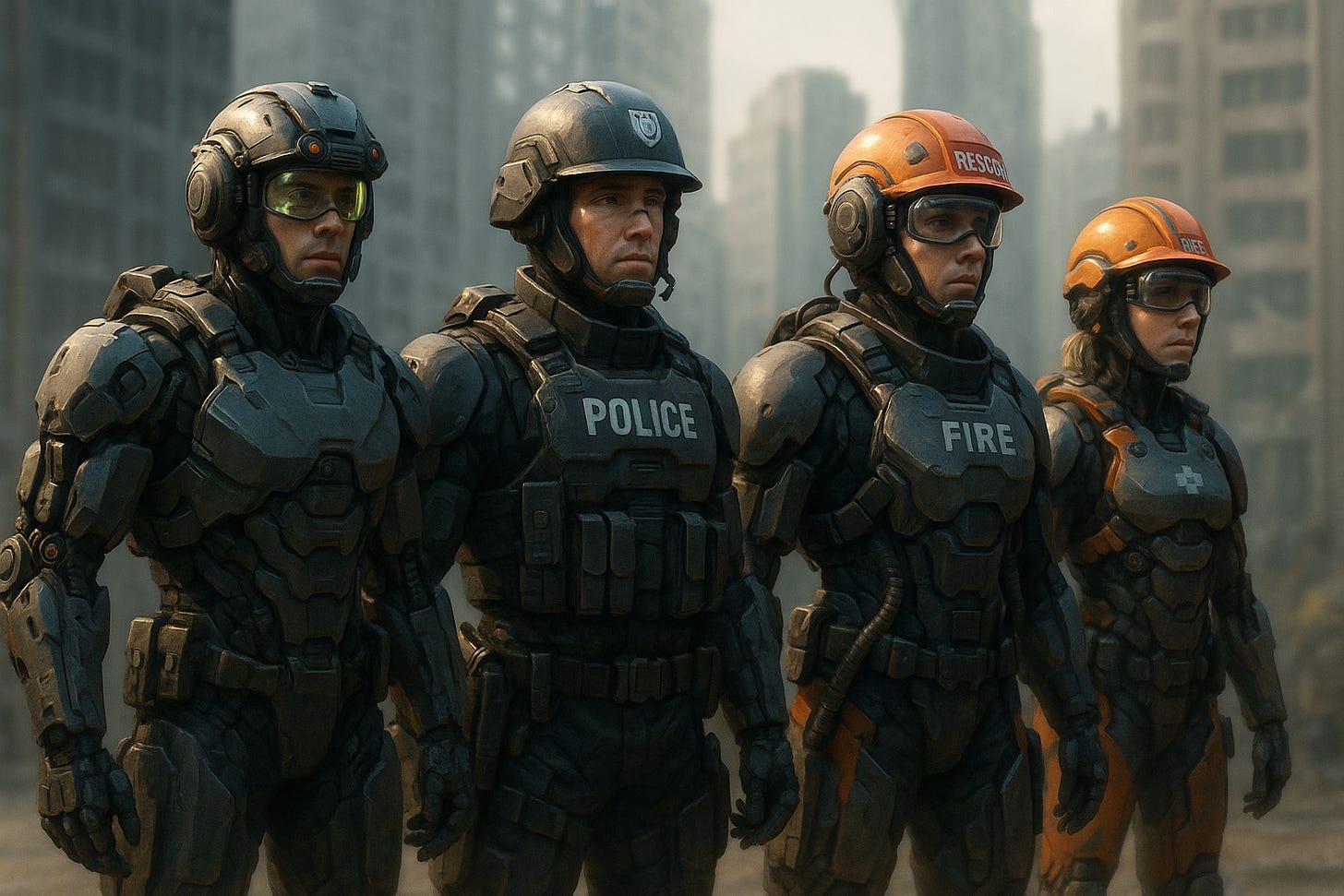

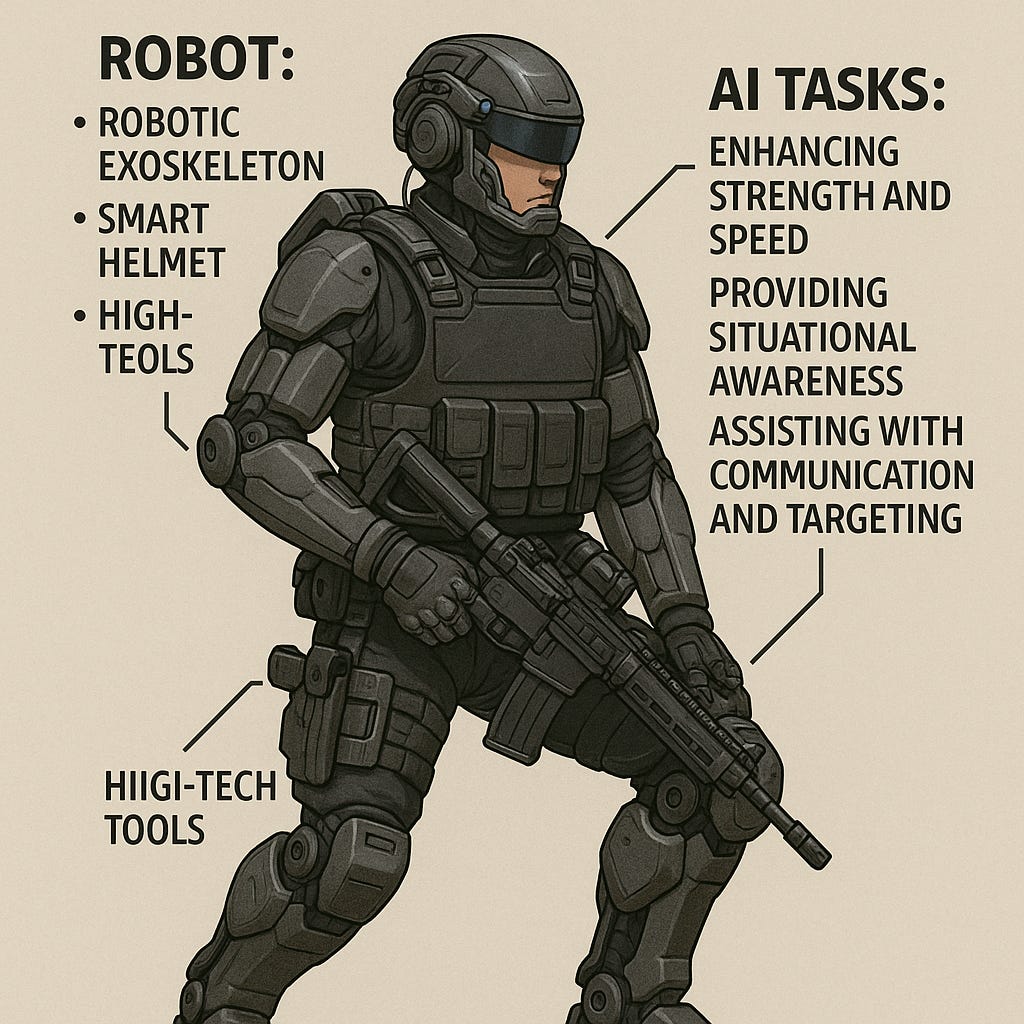



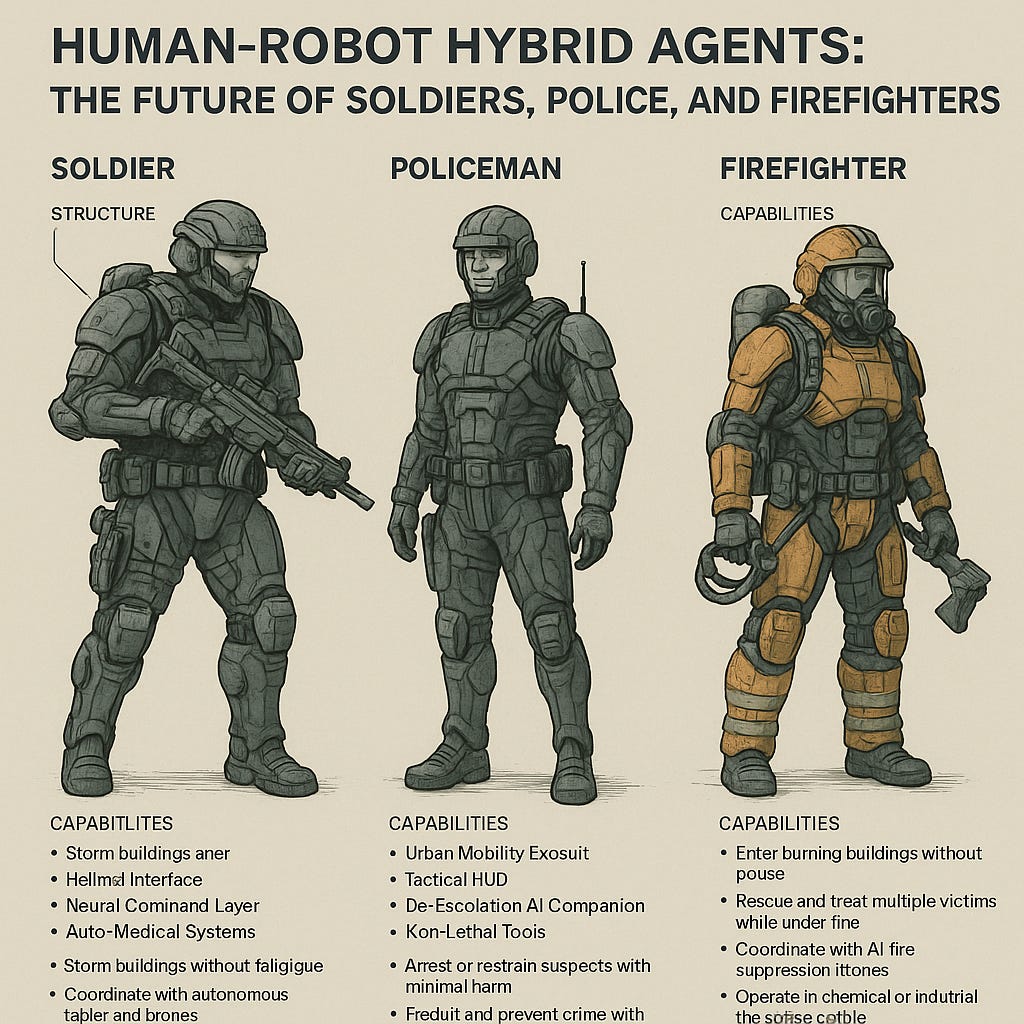
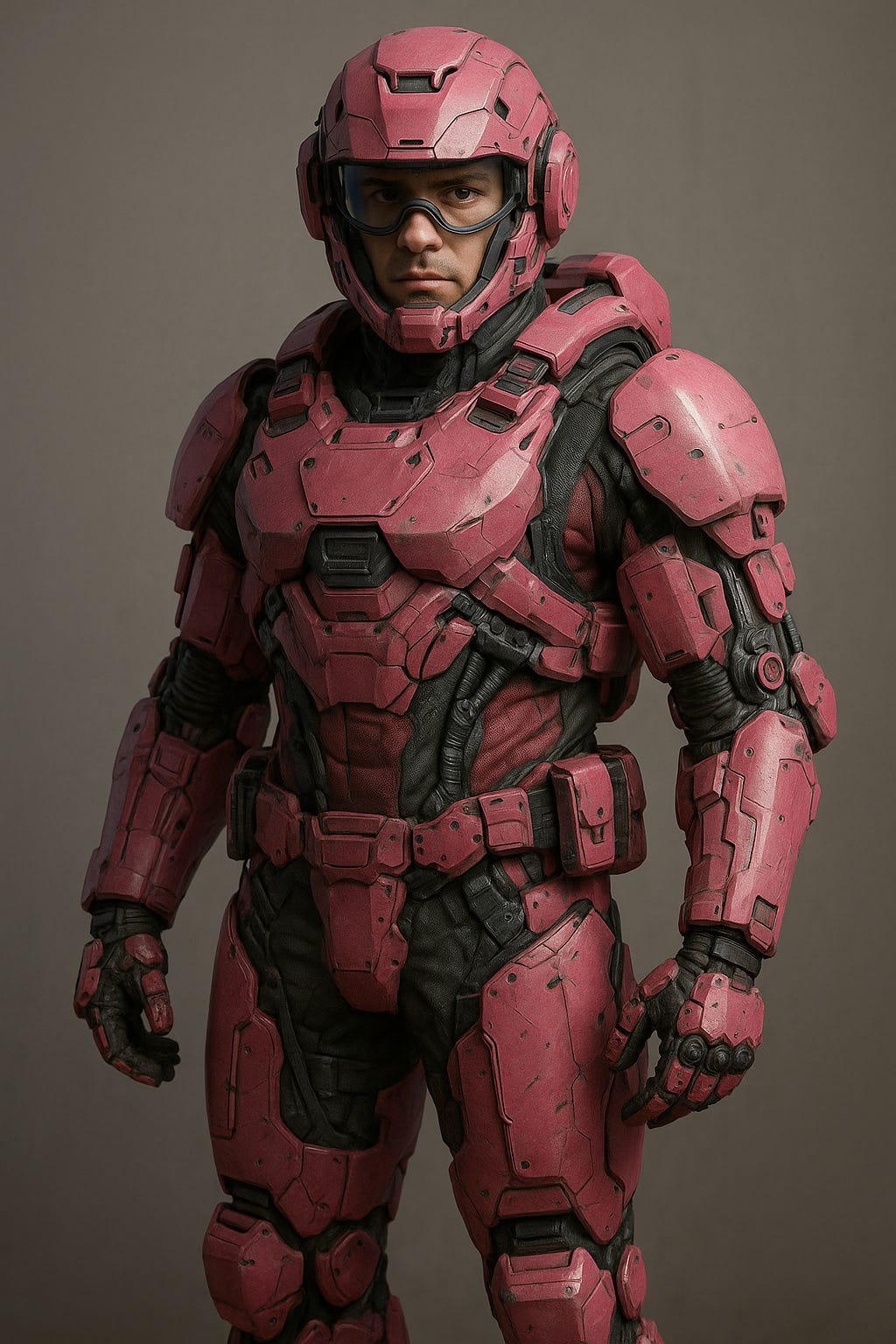







Comments
Post a Comment